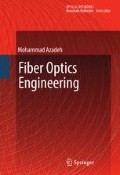As mentioned in Chapter 1, in a fiber optic link an optical source, such as semiconductor laser, converts an electrical signal to an optical signal. The optical signal, once coupled properly into an optical fiber, can travel as a guided wave for relatively long distances. At destination, the optical signal must be converted back from the optical domain to the electrical domain. This conversion is accomplished by using a photodetector, which is a light-sensitive device that converts the received photons into electrons.
Access this chapter
Tax calculation will be finalised at checkout
Purchases are for personal use only
Notes
- 1.
The diode can also generate photocurrent when it is forward biased. This is called the photo-voltaic mode of operation, where light is converted to forward bias current. Photocells work in the photovoltaic mode. However, PIN detectors work in the reverse-biased region, also known as photo-conductive mode.
References
H. Zenk, “Ionization by quantized electromagnetic fields: the photoelectric effect,” Review in Mathematical Physics, Vol. 20, pp. 367–406, 2008
S. M. Sze and K. K. Ng, Physics of Semiconductor Devices , 3rd Ed., John Wiley & Sons, Hoboken, NJ, 2007
A. J. Seeds and K. J. Williams, “Microwave photonics,” Journal of Lightwave Technology, Vol. 24, pp. 4628–4641, 2006
G. Wang et al., “Highly reliable high performance waveguide-integrated InP/InGaAs pin photodiodes for 40 Gbit/s fibre-optical communication application,” Electronics Letters, Vol. 39, pp. 1147–1149, 2003
L. Y. Lin et al., “High-power high-speed photodetectors-design, analysis, and experimental demonstration,” IEEE Transactions on Microwave Theory and Techniques, Vol. 45, pp. 1320–1331, 1997
Y. J. Chiu et al., “GaAs-based, 1.55 μm high speed, high saturation power, low-temperature grown GaAs p-i-n photodetector,” Electronics Letters, Vol. 34, pp. 1253–1255, 1998
Y. J. Chiu et al., “Ultrafast (370 GHz bandwidth) p-i-n traveling wave photodetector using low-temperature-grown GaAs,” Applied Physics Letters, Vol. 71, pp. 2508–2510, 1997
Y. G. Wey et al., “110-GHz GaInAs/InP double heterostructure PIN photodetectors,” Journal of Lightwave Technology, Vol. 13, pp. 1490–1499, 1995
A. R. Williams, A. L. Kellner, and P. K. L. Yu, “Dynamic range performance of a high speed, high saturation InGaAs/InP pin waveguide photodetector,” Electronics Letters, Vol. 31, pp. 548–549, 1995
J. E. Bowers, C. A. Burrus, and R. J. McCoy, “InGaAs PIN photodetectors with modulation response to millimeter wavelengths,” Electronics Letters, Vol. 21, pp. 812–814, 1985
A. Bandyopadhy and M. J. Deen, “Photodetector for optical fiber communications,” in Photodetectors and Fiber Optics , Edited by H. S. Nalwa, pp. 307–368, Academic Press, New York, 2001
M. Lazovic, P. Matavulj P, and J. Radunovic, “The few SPICE models of ultra fast P-i-N photodiode,” Journal of Optoelectronics and Advanced Materials, Vol. 9, pp. 2445–2448, 2007
G. Wang et al., “A time-delay equivalent-circuit model of ultrafast p-i-n photodiodes,” IEEE Transactions on Microwave Theory and Techniques, Vol. 51, pp. 1227–1233, 2003
J. J. Jou et al., “Time-delay circuit model of high-speed p-i-n photodiodes,” IEEE Photonics Technology Letters, Vol.14, pp. 525–527, 2002
K. J. Williams, R. D. Esman, and M Dagenais, “Nonlinearities in p-i-n microwave photodetectors,” Journal of Lightwave Technology, Vol. 14, pp. 84–96, 1996
T. F. Refaat, H. E. Elsayed-Ali, and R. J. DeYoung, “Drift-diffusion model for reach-through avalanche photodiodes,” Optical Engineering, Vol. 40, pp. 1928–1935, 2001
H. Ando, Y. Yamauchi, and N. Susa, “Reach-through type planar InGaAs/InP avalanche photodiode fabricated by continuous vapor phase epitaxy,” IEEE Journal of Quantum Electronics, Vol. 20, pp. 256–264, 1984
E. Garmire, “Sources, modulation, and detectors for fiber-optic communication systems,” in Fiber Optics Handbook , Edited by M. Bass, pp. 4.1–4.78, McGraw-Hill, New York, 2002
J. W. Parks et al., “Theoretical study of device sensitivity and gain saturation of separate absorption, grading, charge, and multiplication InP/InGaAs avalanche photodiodes,” IEEE Transactions on Electron Devices,” Vol. 43, pp. 2113–2121, 1996
J. Campbell et al., “Recent advances in avalanche photodiodes,” IEEE Journal of Quantum Electronics, Vol. 10, pp. 777–787, 2004
R. J. McIntyre, “The distribution of gains in uniformly multiplying avalanche photodiodes: Theory,” IEEE Transactions on Electron Devices, Vol. 19, pp. 703–713, 1972
C. Yeh, Applied Photonics , Academic Press, New York, 1994
Author information
Authors and Affiliations
Corresponding author
Rights and permissions
Copyright information
© 2009 Springer Science+Business Media B.V.
About this chapter
Cite this chapter
Azadeh, M. (2009). PIN and APD Detectors. In: Fiber Optics Engineering. Optical Networks. Springer, Boston, MA. https://doi.org/10.1007/978-1-4419-0304-4_6
Download citation
DOI: https://doi.org/10.1007/978-1-4419-0304-4_6
Published:
Publisher Name: Springer, Boston, MA
Print ISBN: 978-1-4419-0303-7
Online ISBN: 978-1-4419-0304-4
eBook Packages: EngineeringEngineering (R0)

